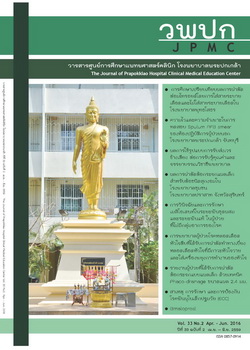การพยาบาลผู้ป่วยโรคหลอดเลือดหัวใจตีบที่ได้รับการผ่าตัด ทำทางเบี่ยงหลอดเลือดหัวใจที่มีภาวะหัวใจวาย และใส่เครื่องพยุงการทำงานของหัวใจ
Main Article Content
Abstract
ที่มาของปัญหา : ผู้ป่วยโรคหลอดเลือดหัวใจตีบที่ได้รับการผ่าตัดทำทางเบี่ยงหลอดเลือดหัวใจที่มีภาวะหัวใจวายและใส่เครื่องพยุงการทำงานของหัวใจมีความเสี่ยงต่อการเสียชีวิตสูง พยาบาลต้องใช้องค์ความรู้ที่เฉพาะร่วมกับประเมินการทำงานเครื่องพยุงการทำงานของหัวใจให้เหมาะสมกับสภาพผู้ป่วยจะป้องกันการเกิดภาวะแทรกซ้อนได้
วัตถุประสงค์ : เพื่อเปรียบเทียบการพยาบาลผู้ป่วยโรคหลอดเลือดหัวใจตีบที่ได้รับการผ่าตัดทำทางเบี่ยงหลอดเลือดหัวใจที่มีภาวะหัวใจวายและใส่เครื่องพยุงการทำงานของหัวใจ
รูปแบบการศึกษา : เป็นการศึกษาเชิงพรรณนา (descriptive study) เปรียบเทียบกรณีศึกษา (case study) จำนวน 2 ราย รายที่ 1 เข้ารับการรักษาระหว่างวันที่ 14 เดือนตุลาคม พ.ศ. 2557 ถึงวันที่ 5 เดือนพฤศจิกายน พ.ศ.2557 รายที่ 2 เข้ารับการรักษาระหว่างวันที่ 24 เดือนมีนาคม พ.ศ.2558 ถึงวันที่ 6 เดือนเมษายน พ.ศ. 2558
ผลการศึกษา : รายที่ 1 ชายไทย อายุ 70 ปี เจ็บแน่นหน้าอกด้านซ้าย ผ่าตัดทำทางเบี่ยงหลอดเลือดหัวใจ 4 เส้น ขณะผ่าตัดมี low cardiac out put ใส่เครื่องพยุงการทำงานของหัวใจนาน 1 วัน มีภาวะหัวใจเต้นผิดจังหวะ ภาวะปอดอักเสบรวมใส่เครื่องช่วยหายใจ 10 วัน มีภาวะน้ำตาลในเลือดสูง ต่อมาอาการดีขึ้นรวมเวลาอยู่ในโรงพยาบาล 22 วัน รายที่ 2 หญิงไทยอายุ 50 ปี เจ็บแน่นหน้าอก เหนื่อย ขาบวม นอนราบไม่ได้ ผ่าตัดทำทางเบี่ยงหลอดเลือดหัวใจ 4 เส้น ขณะผ่าตัดมี low cardiac out put ใส่เครื่องพยุงการทำงานของหัวใจ 2 วัน มีภาวะหัวใจเต้นผิดจังหวะและเกิดซ้ำบ่อยครั้ง ระดับน้ำตาลในเลือดแปรปรวนมาก สามารถถอดเครื่องช่วยหายใจได้ภายใน 1 วัน อาการดีขึ้น รวมระยะเวลาอยู่ในโรงพยาบาลนาน 13 วัน พบว่าผู้ป่วยทั้ง 2 ราย มีประเด็นที่เหมือนกัน คือ อาการแสดง จำนวนเส้นเลือดที่ตีบ มีโรคร่วม แต่มีความแตกต่างกันในด้าน เพศ อายุ การตั้ง setting เครื่องพยุงการทำงานของหัวใจ การหย่าเครื่องช่วยหายใจ การควบคุมระดับน้ำตาลในเลือด และการเตรียมความพร้อมก่อนจำหน่าย
สรุป : การศึกษาครั้งนี้แสดงให้เห็นว่า พยาบาลเป็นผู้ที่มีความสำคัญ ต้องประเมินปัญหาผู้ป่วยได้ตั้งแต่ระยะเริ่มแรกทั้งที่เป็นสาเหตุที่ทำให้เกิดภาวะหัวใจวายและที่เกิดจากการใช้เครื่องพยุงการทำงานของหัวใจ จะช่วยให้ผู้ป่วยปลอดภัยและกลับบ้านได้เร็ว
คำสำคัญ : การพยาบาล โรคหลอดเลือดหัวใจตีบ; ภาวะหัวใจวาย; เครื่องพยุงการทำงานของหัวใจ; การผ่าตัดทำทางเบี่ยงหลอดเลือดหัวใจ
Nursing Care of Coronary Artery Disease Patient after Coronary Artery Bypass Graft Surgery with Heart Failure and Intra-aortic Balloon Pump.
Background : The patient who had coronary artery disease after coronary artery bypass graft surgery with heart failure and intra-aortic balloon pump was high risk to die, so that the advanced and special nursing care is needed to do the symptom assessment on patients and help prevent them from postoperative complications.
Purpose : To compare the two patients after coronary artery bypass graft surgery and Intra aortic balloon pump.
Scope of the Study: Descriptive research on case study of the two patients after Coronary Artery Bypass Graft Surgery with Heart Failure and Intra-aortic Balloon Pump. The first patient from October 24, 2014 to Novenber 5, 2014. The second patient from March 24, 2015 to April 6, 2015.
Results: The finding was found that there were differences in severity of pathology coronary artery disease such as diabetic hypertension and hyperlypidemia. The first patient was more severity of pathology coronary artery disease than was the second patient. The first patient; seventy years old, Thai male was found congestive heart failure and pulmonary congestion, curing by insert intra-aortic balloon pump. Pneumonia was found due to prolong intubation endotracheal tube last to ten days, and took a hospital stay for twenty two days. The second patient; fifty years old, Thai female was found congestive heart failure, cured by insert intra-aortic balloon pump. Cardiac arrhythmia was found and, cured by medication and recovered in two days, a day on endotracheal tube, and took a hospital stay for thirteen days.
Conclusion: The study showed that nursing care was the most important factor to help symptom assessment at preoperative and postoperative that caused heart failure so that the patients would early and safety recover.
Keywords: Nursing care, Coronary artery disease, Heart failure, Intra-aortic balloon pump, Coronary artery bypass

